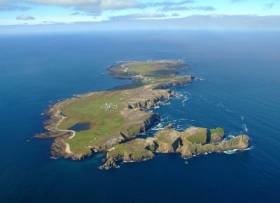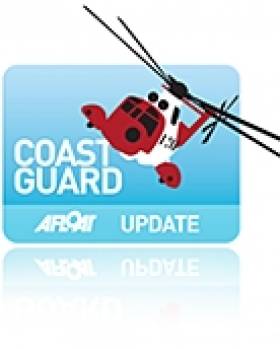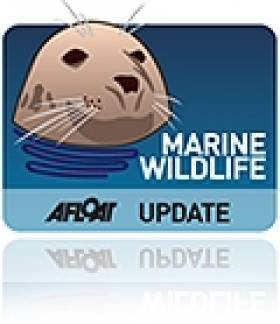Displaying items by tag: Tory Island
#islandnews - News that a new ferry has been sanctioned for Tory Island off Co. Donegal has been welcomed – but there are still concerns over what vessel will be used until the new ferry comes on line.
According to Highland Radio, residents on the island were furious to learn that a 40 year-old ferry was being brought in on the crossing with concerns being expressed over its suitability and safety.
They had threatened to not use the service at all and following a meeting with Minister Joe McHugh, it was announced that €4 million would now be made available for a custom built ferry.
Islander Daniel Cullen says the news is welcome, but they need some reassurances. To hear a podcast of the islanders comment, click this link and scroll down the page.
Three Men & A Dog Rescued By Coastguard
#Coastguard - Waterford's coastguard helicopter went to the aid of three men and a dog whose boat was grounded on a sandbank near Rosslare Strand yesterday evening (Wednesday 23 December).
As BreakingNews.ie reports, coastguard units from Rosslare and Carnsore joined Rescue 117 in the operation, with the helicopter airlifting the men and their dog to safety.
Elsewhere, the Sligo-based Irish Coast Guard chopper Rescue 118 flew nine stranded islanders home to Tory Island yesterday, according to Independent.ie.
The coastguard stepped in to fly the nine passengers along with post and other supplies to the island off the Donegal mainland after ferry services were disrupted by Storm Eva.
TheJournal.ie has photos of the serious swells the storm brought to the North West coast in particular.
Coast Guard Helicopter Bringing Christmas Cheer to Tory Island
The Sligo based Coast Guard helicopter, Rescue 118, is helping to bring Christmas cheer to Tory Island off the Donegal coast. Nine (9) islanders who otherwise would not have got home for Christmas are this afternoon being flown from Donegal Airport in Carrickfinn, to the island. A backlog of Christmas post and fresh supplies* for the island population were also carried on the flight.
The recent spell of bad weather which has extended into Storm Eva, has severely interrupted ferry services to and from the island resulting in few opportunities for locals to return home for Christmas. Deliveries of post and fresh goods have also been interrupted.
It has been a busy year for Coast Guard helicopters with almost one thousand missions completed to date by the service. This work includes assistance provided to HSE with patient transfer.
Over the Christmas period many people will be engaging in outdoor activities. The Coast Guard is strongly urging the public not to engage in any activity unless they have first checked that it is safe to do so; especially when planning to go on exposed coasts, cliffs, piers, harbour walls, beaches, promenades or other coastal areas.
The Coast Guard wishes to remind the public that if you see anybody in trouble at sea, on the coast or on cliffs to call 112 and ask for the Coast Guard.
Shannon Helicopter Goes The Distance for Donegal Rescue
#COASTGUARD - The Shannon-based Irish Coast Guard rescue helicopter was dispatched to the Donegal coast on Friday night to rescue a young boy seriously injured in a farming accident.
As the Clare Herald reports, Rescue 115 - which only entered service a month ago - was called on to make the long-distance journey after the Sligo coastguard chopper was grounded by technical problems.
The mission put Shannon's new Sikorsky S92A craft's long-range capabilities and specialist medical equipment to the test, as it flew from Clare to Tory Island via Sligo General Hospital to evaculate the six-year-old boy, airlifting him to Letterkenny General Hospital for treatment.
As previously reported on Afloat.ie, the Irish Coast Guard took delivery of the new chopper at its Shannon base earlier this year as part of the rescue service's €500 million deal with CHC Ireland to revamp the aircraft fleet. Shannon is the only base to receive a brand new helicopter as part of the contract.
Equipped for dedicated search and rescue operations, the Sikorsky S92A provides coverage for deep Atlantic Ocean missions, services Ireland's offshore islands and provides rescue cover on the west coast from Cork to Galway.
Boats Head for 'Foyle Days' 2011
Over the years she has changed hands between Dutch and UK interests for recreational use. Several years ago she starred in the RTE TV reality show 'Cabin Fever' where she replaced the show's first ship Camaret of Cornwall (branded as 'Cabin Fever') after it ran aground off Tory Island.
During the two-day festival (11am-5pm) the boating community at the event will include the Coleraine Yacht Club, Foyle Paddlers, Foyle Punts, Lough Foyle Yacht Club, Lough Swilly Yacht Club, Moville Boat Club, RNLI and the Foyle (SAR) Search and Rescue.
Visitors to Foyle Days can call to the Clipper stand and learn more about the city's entry of the Derry~Londonderry boat in the 2011-2012 Clipper Round the World Race. Learn more about the countries the crew will visit and also how to get involved in the event. For more information about the race, at 40,000 miles is the world's longest race go to www.clipperroundtheworld.com/
Running alongside the festival a continental market with 40 stalls will be open to all at the recently revamped Guildhall Square. For further details about Foyle Days click here.
- Clipper Race
- Maritime Festival
- RNLI
- Lough Foyle Yacht Club
- Lough Swilly Yacht Club
- Moville Boat Club
- Derry
- Londonderry
- Tory Island
- JOHANNA LUCRETIA
- Foyle Days
- RTE TV
- Cabin Fever
- Camaret of Cornwall
- Grounding
- Reality TV show
- Clipper Around the World Race
- Guildhall Square
- Continental Market
- Coleraine Yacht Club
- Foyle Search and Rescue
- Foyle Paddlers
- Foyle Punts
- Offshore Sailing
- Clipper Round The World Race
- JOHANNA LUCRETIA
Ireland Sees Largest Aggregation of Killer Whales
The Irish Whale and Dolphin Group (IWDG) has announced the largest aggregation of killer whales to date in Irish waters.
As many as a dozen killer whales, or orca, were spotted close to an Irish Naval Service vessel on patrol 30 miles off Tory Island in Co Donegal late last month.
According to Lt Cmdr Paddy Harkin of the LE Niamh, the killer whales were feeding among large shoals of mackerel that also attracted a large number of fishing vessels.
He added that the whales had apparently followed the mackerel from west of the Hebrides in north west Scotland, according to several fishing skippers - who placed their numbers at over 100.
The IWDG has more on the story (including photos) HERE.
































































